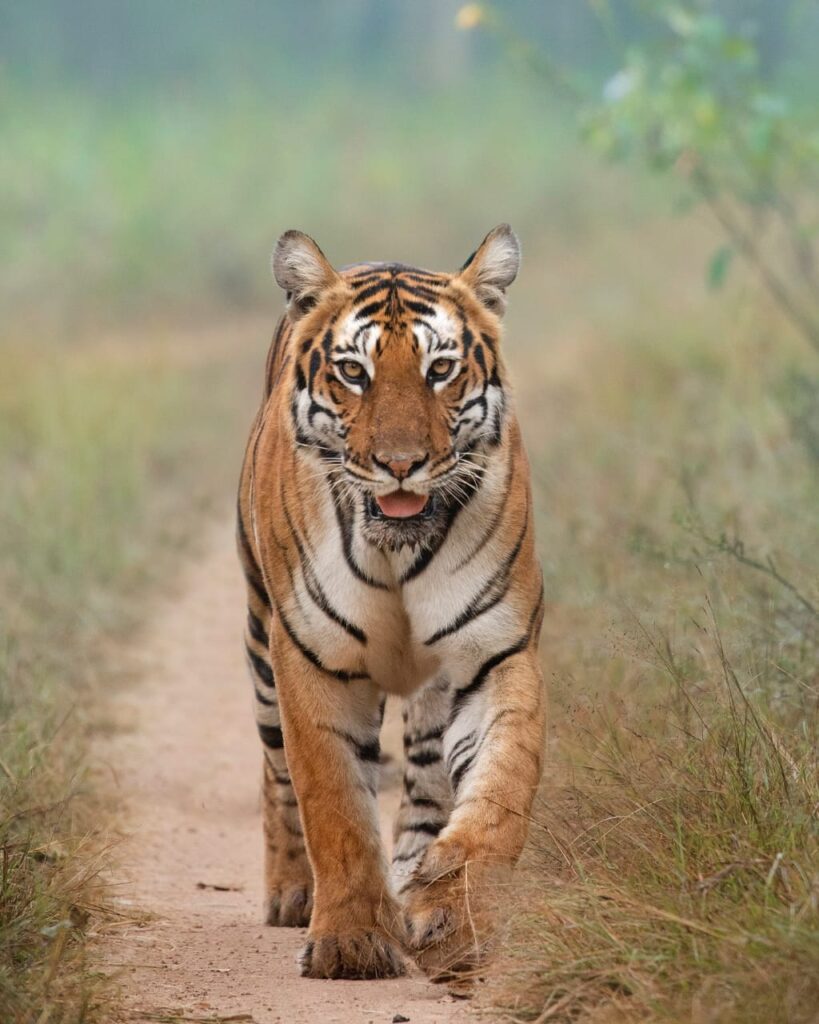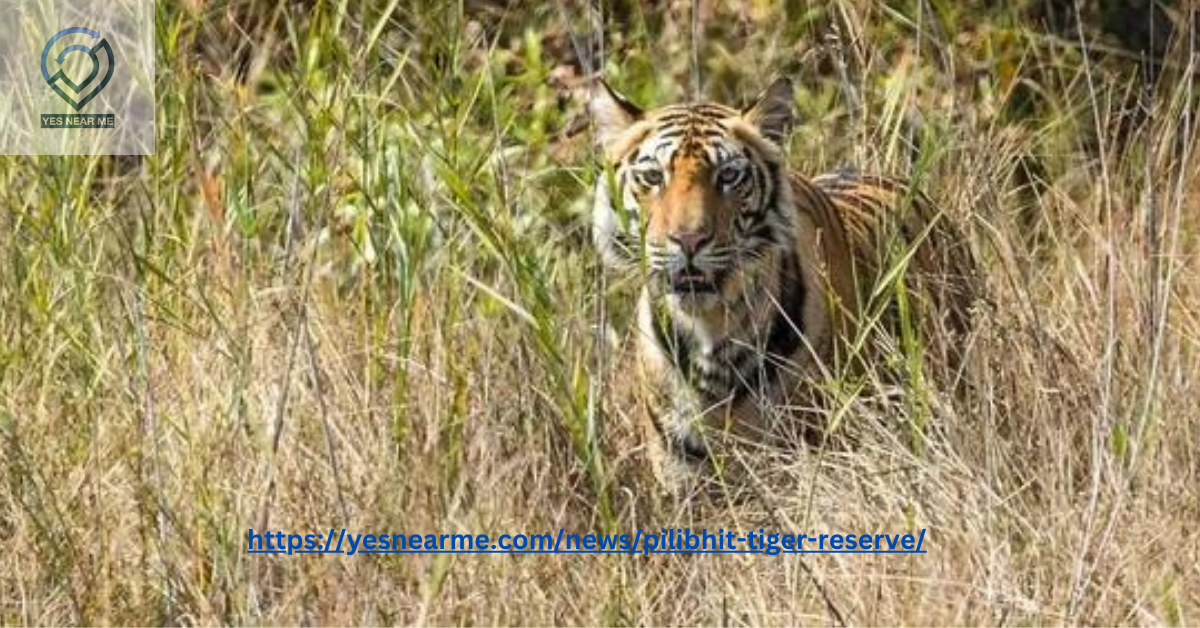Pilibhit Tiger Reserve: A Jewel of the Terai Region
Introduction

Pilibhit Tiger Reserve, located in the Terai region of Uttar Pradesh, India, is one of the finest examples of a well-preserved forest ecosystem. Established as a tiger reserve in 2008, Pilibhit is known for its thriving population of Royal Bengal Tigers and its rich biodiversity. Covering an area of approximately 730 square kilometers, the reserve is characterized by dense forests, lush grasslands, and numerous water bodies, making it an ideal habitat for various species of flora and fauna.
The reserve is a part of India’s conservation efforts under Project Tiger and plays a crucial role in preserving the country’s rich wildlife heritage. The presence of riverine forests and swamps makes Pilibhit unique among India’s tiger reserves, offering a diverse range of habitats for many endangered species.
History of Pilibhit Tiger Reserve
The forests of Pilibhit have long been known for their ecological importance. Historically, the area was used as a hunting ground by the British and Indian royalty. However, the need for conservation was recognized in the late 20th century due to the increasing threats to wildlife from deforestation, human encroachment, and poaching.
In 2008, the Government of India declared Pilibhit a tiger reserve under Project Tiger, making it one of the newer additions to India’s network of protected areas. Since then, conservation efforts have been intensified to protect the tiger population and the reserve’s fragile ecosystem.
Geography and Climate
Pilibhit Tiger Reserve is located in the foothills of the Himalayas, forming a vital part of the Terai Arc Landscape. It shares its boundaries with Nepal and is adjacent to the Shuklaphanta National Park in Nepal, allowing free movement of wildlife between the two countries. The reserve is bordered by the Sharda River on the east and the Ghaghra River on the south, making it a water-rich habitat for various species.
Climate
The climate of Pilibhit is influenced by its location in the Terai belt. It experiences three main seasons:
- Summer (March to June): Temperatures range from 25°C to 40°C, with high humidity.
- Monsoon (July to September): The reserve receives heavy rainfall, revitalizing the flora and increasing water levels in rivers and wetlands.
- Winter (October to February): The best season for wildlife tourism, with temperatures ranging from 10°C to 25°C, providing clear visibility and a pleasant climate.
Flora of Pilibhit Tiger Reserve

Pilibhit’s rich and diverse vegetation is primarily composed of:
- Sal Forests (Shorea robusta): Dominant across the reserve, providing shelter and food for various herbivores and birds.
- Grasslands: Known as ‘Chaurs,’ these grasslands are essential grazing grounds for deer and other herbivores.
- Riverine Forests: Found along riverbanks, supporting a variety of aquatic and semi-aquatic species.
- Wetlands and Swamps: Important for waterfowl, amphibians, and reptiles.
- Bamboo Groves: Providing additional cover and food for elephants and other herbivores.
Fauna of Pilibhit Tiger Reserve
Mammals
- Royal Bengal Tiger (Panthera tigris tigris): The apex predator and the primary conservation focus of the reserve.
- Leopard (Panthera pardus): Found in the denser parts of the forest.
- Indian Elephant (Elephas maximus indicus): Occasionally migrates from neighboring forests.
- Swamp Deer (Rucervus duvaucelii): One of the rarest deer species, found in wetland areas.
- Sambar Deer (Rusa unicolor): The largest deer species in India, commonly seen in the reserve.
- Chital (Axis axis): A spotted deer species that thrives in grasslands.
- Barking Deer (Muntiacus muntjak): Known for its loud alarm calls.
- Sloth Bear (Melursus ursinus): A nocturnal species, often seen searching for termites and fruits.
- Striped Hyena (Hyaena hyaena): A scavenger that plays a crucial role in the ecosystem.
- Indian Jackal (Canis aureus): Commonly found in grasslands and open forests.
Birds

Pilibhit Tiger Reserve is a birdwatcher’s paradise, with over 300 recorded species, including:
- Great Hornbill (Buceros bicornis)
- Crested Serpent Eagle (Spilornis cheela)
- Sarus Crane (Grus antigone)
- Lesser Adjutant Stork (Leptoptilos javanicus)
- Indian Peafowl (Pavo cristatus)
- Black-necked Stork (Ephippiorhynchus asiaticus)
Reptiles and Amphibians
- Marsh Crocodile (Crocodylus palustris): Found in the reserve’s water bodies.
- Indian Rock Python (Python molurus): A non-venomous snake often spotted in the reserve.
- King Cobra (Ophiophagus hannah): The world’s longest venomous snake.
- Gharial (Gavialis gangeticus): An endangered species found in the Sharda River.
Conservation Efforts
Pilibhit Tiger Reserve is actively involved in conservation projects, including:
- Project Tiger: Focused on increasing tiger populations through habitat protection and anti-poaching measures.
- Community Involvement: Local communities are engaged in conservation activities and eco-tourism initiatives.
- Anti-Poaching Patrols: Regular monitoring by forest guards and use of technology like camera traps.
- Afforestation and Habitat Restoration: Replanting of native vegetation and wetland conservation.
- Wildlife Corridors: Maintaining connectivity with other protected areas to ensure genetic diversity among wildlife populations.
Tourism and Safari Options
Pilibhit Tiger Reserve is an emerging eco-tourism destination, attracting wildlife enthusiasts from across the country.
Types of Safaris
- Jeep Safari: A guided open-vehicle tour offering an up-close experience of the reserve’s wildlife.
- Elephant Safari: Limited availability, providing a unique perspective of the forest.
- Walking Trails: Guided nature walks for birdwatchers and nature lovers.
Best Time to Visit
The ideal time to visit Pilibhit is from November to April, when the weather is pleasant and wildlife sightings are frequent.
Entry Fees and Timings
- Entry fees vary based on nationality and safari type.
- Safaris are conducted in the morning and late afternoon for optimal wildlife sightings.
Nearby Attractions
Visitors to Pilibhit can explore other nearby natural and cultural attractions, such as:
- Dudhwa National Park: Another famous tiger reserve in the Terai region.
- Shuklaphanta National Park (Nepal): Adjacent to Pilibhit, offering cross-border wildlife migration.
- Chuka Beach: A picturesque location on the banks of the Sharda River.
- Gauri Shankar Temple: A historic temple in Pilibhit town.
Responsible Tourism Guidelines
Visitors to Pilibhit Tiger Reserve are encouraged to:
- Follow all forest department rules and regulations.
- Avoid littering and maintain the cleanliness of the reserve.
- Respect wildlife by keeping a safe distance and avoiding loud noises.
- Refrain from feeding animals or interfering with their natural behavior.
- Support eco-tourism initiatives that benefit local communities.
Conclusion
Pilibhit Tiger Reserve is a crucial part of India’s wildlife conservation efforts, offering a safe haven for tigers and numerous other species. Its unique landscape, rich biodiversity, and conservation success make it one of India’s most important tiger reserves. By promoting responsible tourism and continued conservation efforts, Pilibhit will remain a thriving ecosystem for future generations.
P22J+6FR, District Pilibhit, Pilibhit, Uttar Pradesh 262122
Information about Air Routes
The closest airports are at Lucknow and Bareilly, both of which offer direct flights to all of India’s main cities.
By Highway
From New Delhi>Muradabad>Bareilly>Pilibhit From Lucknow>Sitapur>Shahjahanpur>Pilibhit By Train
Purnagiri Express departs from Delhi from 6 am to 4 pm.
Timings for Pilibhit Tiger Reserve Safari
Summer: (April 1 through June 15)
6 a.m. to 9 a.m., 3 p.m. to sundown
Winter: (from November 1 to March 31)
from 630 to 10:00 and from 2:30 to sundance
Purchasing Jungle Safari points
Pilibhit Assam Chauraha,
Nehru Urja Udyan
Sahid Surendra Singh Park
Mustfabad Gate and
Mahof Gate in Puranpur
Safari Ride Charges
| Serial no. | Safari departure point | Booking fee (Rs.) |
| 1. | Mustafabad | 3500.00 |
| 2. | Kishanpur | 2700.00 |
Contact Us -:
Jungle Safari & Rooms Bookings
+91 9871350805
OR
Visit Website -:
https://pilibhittigerreserve.com/
For More Updates About Other Tiger Reserve Please Visit https://yesnearme.com/news/
THANK YOU







Recent Comments